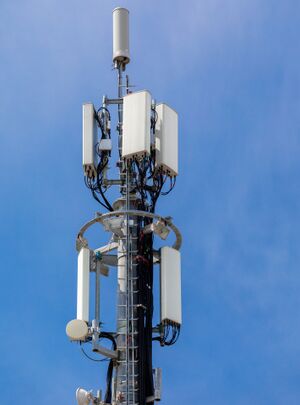Cellular communications
Introduction
As mobile phone density has increased world wide, cellular communications have been increasingly reached for during an environmental disaster, wartime, and other crises. However, like any powered infrastructure, this communications technology is vulnerable to blackouts. Further, cell tower (or 'cell site') base stations and repeaters are dependent on the integrity of the structure to which they are affixed, and so as vulnerable to the effects of storms, earthquakes and floods as the building or radio mast to which they are attached.
This page will look at the disaster tolerance of cellular communications, detail work done to improve reliability in a crisis situation, and provide solutions implementable and maintainable by communities in service to their own needs, providing inexpensive low-power wide-area mobile phone telephony.
Anatomy of a cell tower

Antennae, and the equipment comprising a cellular base station, are typically mounted onto a radio mast, or other raised structure, like a building. Sometimes the structure is disguised as other things, like a tree, or as bricks, so as to blend in with the local environment.
A cell tower acts as a single 'cell' within a network of other inter-connected cells, allowing for the seamless registration and migration of handsets (mobile phones) from cell to cell as they move across the geography. This inter-connection with neighbouring cell sites is done with the application of a dedicated point-to-point directional antenna (focused radio 'beams' transmit and receive along one direction) known as a remote radio head. These special antenna typically transmit and receive on microwave (sub-millimeter wavelenth bands). The other directional antennae on a cell tower is typically of the flat-panel type, are for traffic to-and-fro handsets.
One way to tell the difference between phone-facing and cell-facing antennae in a dense urban environment is that the surface of the remote radio head is typically perpendicular to the ground (pointing to another cell site), whereas the directional antenna facing phones is angled slightly downward, for instance to a road or street. Remote radio heads are also often round, with a flat surface like a drum (as shown in this section's photograph). The antennae are all connected to their respective individual base stations, often housed inside rigid plastic weatherproof boxes, and connected to the local electricity grid. Sometimes the base stations are hidden within the tower structure, or in a dedicated structure built at its base.
In some cases the cell tower will have redundant power supply in the form of a battery array or generator. Generators are often diesel, with a large tank of diesel supply.
Multiple providers will often mount their equipment to the same structure, sharing the rates and lease cost presiding over the structure.
Standards
At the current time there are two dominant cellular communications systems in use: CDMA (used primarily throughout the United States, South Korea and Japan) and GSM, which is used everywhere else, also including some parts of the United States.